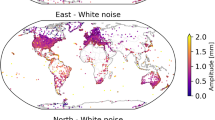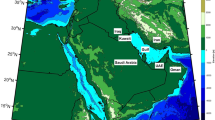Abstract
We adopt the cross wavelet transform (XWT) to examine the potential geophysical contributors of seasonal oscillations in GPS observations. Daily vertical GPS position time series and mass loadings [atmospheric, oceanic, and hydrological loading (AOH)] of 30 globally distributed GPS sites, spanning from January 2002 to December 2014, are used to quantify the performance. First, we examine the spectra of GPS time series and AOH. The results confirm the anomalous sub-seasonal peaks in GPS spectra are seen to have not an obvious geophysical explanation. The Akaike information criteria is then used to quantify how well the noise models fit the two series. The Generalized Gauss Markov plus white noise (GGM + WH) model is in most cases the preferred noise model for GPS, and the fifth order autoregressive plus white noise (AR(5) + WH) model is the preferred noise model for AOH. Second, we test the significance of periodic oscillations in GPS residuals and AOH. We find both series have significantly high power located near one cycle per year frequency band, whereas harmonic signals at higher draconitic frequency are identified as non-white process. Finally, we adopt XWT to examine the relative phasing between the two series, and find the annual variations in two series are physically related for most sites. The time variable phase asynchrony obtained using the XWT-based semblance analysis confirms that the annual variations in GPS observations are resulting from a combination of geophysical signals and systematic errors. The weighted least squares fitting method where the covariance matrix follows a specific stochastic noise model is also performed for comparison.








Similar content being viewed by others
References
Akaike H. (1974), A new look at the statistical model identification, IEEE Transactions on Automatic Control, 19, 716–723.
Altamimi Z., X. Collilieux, J. Legrand, B. Garayt and C. Boucher (2007), ITRF2005: A new release of the International Terrestrial Reference Frame based on time series of station positions and Earth Orientation Parameters, Journal of Geophysical Research: Solid Earth, 112, B09401.
Amiri-Simkooei A., C. Tiberius and P. Teunissen (2007), Assessment of noise in GPS coordinate time series: methodology and results, Journal of Geophysical Research: Solid Earth, 112, B07413.
Barrett P. (2008), The relative contribution of the annual and draconitic periods in GPS station position spectra. 2008 IGS Workshop National Geodetic Survey, Miami Beach. Florida, USA.
Bock Y., B. Crowell, D. Dong, P. Fang, S. Kedar, Z. Liu, A. Moore, S. Owen, L. Prawirodirdjo and M. Squibb (2011), Evaluation of transient deformation from two decades of continuous GPS time series analysis in Western North America. AGU Fall Meeting Abstracts. G53C-01.
Bock Y., S. Kedar, A. W. Moore, P. Fang, J. Geng, Z. Liu, D. Melgar, S. E. Owen, M. B. Squibb and F. Webb (2016), Twenty-Two Years of Combined GPS Products for Geophysical Applications and a Decade of Seismogeodesy. International Association of Geodesy Symposia. Springer Berlin Heidelberg Berlin, Heidelberg, 1–6.
Bos M., R. Fernandes, S. Williams and L. Bastos (2008), Fast error analysis of continuous GPS observations, Journal of Geodesy, 82, 157–166.
Boy J. P. (2014), Precise computation of loading effects for various geodetic observations, EGU General Assembly Conference Abstracts, 16, 7102.
Carrère L. and F. Lyard (2003), Modeling the barotropic response of the global ocean to atmospheric wind and pressure forcing-comparisons with observations, Geophysical Research Letters, 30, 1275.
Chousianitis K., A. Ganas and C. P. Evangelidis (2015), Strain and rotation rate patterns of mainland Greece from continuous GPS data and comparison between seismic and geodetic moment release, Journal of Geophysical Research: Solid Earth, 120, 3909–3931.
Chousianitis K., A. Ganas and M. Gianniou (2013), Kinematic interpretation of present-day crustal deformation in central Greece from continuous GPS measurements, Journal of Geodynamics, 71, 1–13.
Collilieux X., Z. Altamimi, D. Coulot, T. van Dam and J. Ray (2010), Impact of loading effects on determination of the International Terrestrial Reference Frame, Advances in Space Research, 45, 144–154.
Collilieux X., T. van Dam, J. Ray, D. Coulot, L. Métivier and Z. Altamimi (2012), Strategies to mitigate aliasing of loading signals while estimating GPS frame parameters, J Geod, 86, 1–14.
Cooper G. and D. Cowan (2008), Comparing time series using wavelet-based semblance analysis, Computers and Geosciences, 34, 95–102.
Dong D., P. Fang, Y. Bock, M. K. Cheng and S. Miyazaki (2002), Anatomy of apparent seasonal variations from GPS-derived site position time series, Journal of Geophysical Research: Solid Earth, 107, 2075.
Dong D., T. A. Herring and R. W. King (1998), Estimating regional deformation from a combination of space and terrestrial geodetic data, Journal of Geodesy, 72, 200–214.
Dong D., L. Prawirodirdjo, S. Kedar, P. Fang, B. Newport, P. Jamason, F. Webb and Y. Bock (2004), Improved GPS time series in Southern California through the combination of SOPAC and JPL solutions. AGU Fall Meeting Abstracts. G21A-0128.
Farge M. (1992), Wavelet transforms and their applications to turbulence, Annual review of fluid mechanics, 24, 395–458.
Gegout P., J. P. Boy, J. Hinderer and G. Ferhat (2010), Modeling and Observation of Loading Contribution to Time-Variable GPS Sites Positions. In: S. P. Mertikass (ed.), Gravity, Geoid and Earth Observation. Springer Berlin Heidelberg, 651–659.
Gegout P. and G. E. Toulouse (2013), Modeling and Mitigating Loading Effects on Geodetic Sites. EGU General Assembly Conference Abstracts. 9216.
Grinsted A., J. C. Moore and S. Jevrejeva (2004), Application of the cross wavelet transform and wavelet coherence to geophysical time series, Nonlinear processes in geophysics, 11, 561–566.
Jiang W., Z. Li, T. van Dam and W. Ding (2013), Comparative analysis of different environmental loading methods and their impacts on the GPS height time series, Journal of Geodesy, 87, 687–703.
King M. A. and C. S. Watson (2010), Long GPS coordinate time series: Multipath and geometry effects, Journal of Geophysical Research: Solid Earth, 115, B04403.
King M. A., C. S. Watson, N. T. Penna and P. J. Clarke (2008), Subdaily signals in GPS observations and their effect at semiannual and annual periods, Geophysical Research Letters, 35, L03302.
Langbein J. (2004), Noise in two-color electronic distance meter measurements revisited, Journal of Geophysical Research: Solid Earth, 109, B04406.
Mao A., C. G. Harrison and T. H. Dixon (1999), Noise in GPS coordinate time series, Journal of Geophysical Research: Solid Earth, 104, 2797–2816.
Nikolaidis R. (2002), Observation of geodetic and seismic deformation with the global positioning system. University of California San Diego.
Nordman M., J. Mäkinen, H. Virtanen, J. M. Johansson, M. Bilker-Koivula and J. Virtanen (2009), Crustal loading in vertical GPS time series in Fennoscandia, Journal of Geodynamics, 48, 144–150.
Petrov L. and J.-P. Boy (2004), Study of the atmospheric pressure loading signal in very long baseline interferometry observations, Journal of Geophysical Research: Solid Earth, 109, B03405.
Ray J., Z. Altamimi, X. Collilieux and T. van Dam (2008), Anomalous harmonics in the spectra of GPS position estimates, GPS Solut, 12, 55–64.
Ray J., J. Griffiths, X. Collilieux and P. Rebischung (2013), Subseasonal GNSS positioning errors, Geophysical Research Letters, 40, 5854–5860.
Rodell M., P. R. Houser, U. Jambor, J. Gottschalck, K. Mitchell, C. J. Meng, K. Arsenault, B. Cosgrove, J. Radakovich, M. Bosilovich, J. K. Entin, J. P. Walker, D. Lohmann and D. Toll (2004), The Global Land Data Assimilation System, Bulletin of the American Meteorological Society, 85, 381–394.
Santamaría-Gómez A., M.-N. Bouin, X. Collilieux and G. Wöppelmann (2011), Correlated errors in GPS position time series: implications for velocity estimates, Journal of Geophysical Research: Solid Earth, 116, B01405.
Scargle J. D. (1982), Studies in astronomical time series analysis. II-Statistical aspects of spectral analysis of unevenly spaced data, The Astrophysical Journal, 263, 835–853.
Sen A. K., G. M. Filippelli and J.-A. Flores (2009), An application of wavelet analysis to paleoproductivity records from the Southern Ocean, Computers and Geosciences, 35, 1445–1450.
Timmer J. and M. König (1995), On generating power law noise, Astronomy and Astrophysics, 300, 707.
Torrence C. and G. P. Compo (1998), A practical guide to wavelet analysis, Bulletin of the American Meteorological society, 79, 61–78.
Tregoning P., C. Watson, G. Ramillien, H. McQueen and J. Zhang (2009), Detecting hydrologic deformation using GRACE and GPS, Geophysical Research Letters, 36, L15401.
van Dam T., X. Collilieux, J. Wuite, Z. Altamimi and J. Ray (2012), Nontidal ocean loading: amplitudes and potential effects in GPS height time series, Journal of Geodesy, 86, 1043–1057.
Vaughan S. (2005), A simple test for periodic signals in red noise, Astronomy and Astrophysics, 431, 391–403.
Wessel P. and W. Smith (1998), New, Improved Version of Generic Mapping Tools Released, EOS Trans. Am. Geophys. Union, 79, 579.
Williams S. D., Y. Bock, P. Fang, P. Jamason, R. M. Nikolaidis, L. Prawirodirdjo, M. Miller and D. J. Johnson (2004), Error analysis of continuous GPS position time series, Journal of Geophysical Research: Solid Earth, 109, B03412.
Williams S. D. P. and N. T. Penna (2011), Non-tidal ocean loading effects on geodetic GPS heights, Geophysical Research Letters, 38, L09314.
Wu X., M. B. Heflin, E. R. Ivins, D. F. Argus and F. H. Webb (2003), Large-scale global surface mass variations inferred from GPS measurements of load-induced deformation, Geophysical Research Letters, 30, 1742.
Zar J. H. (1999), Biostatistical analysis, Prentice hall, New Jersey.
Acknowledgments
The author would like to thank the editor José Fernández and anonymous reviewers for their useful comments. This research is benefitted from the availability of JPL and SOPAC data products. We thank EOST/IPGS loading service for sharing the load induced deformation, Aslak Grinsted for providing Matlab routines for XWT, and Machiel S. Bos for providing the Hector software. Some figures in this paper are plotted with the Generic Mapping Tools (GMT) software (Wessel and Smith 1998). This study was supported by the Research Project of Department of Water Resources of Zhejiang Province of China (No. RC1303).
Author information
Authors and Affiliations
Corresponding author
Rights and permissions
About this article
Cite this article
Xu, C. Investigating Mass Loading Contributors of Seasonal Oscillations in GPS Observations Using Wavelet Analysis. Pure Appl. Geophys. 173, 2767–2775 (2016). https://doi.org/10.1007/s00024-016-1301-4
Received:
Revised:
Accepted:
Published:
Issue Date:
DOI: https://doi.org/10.1007/s00024-016-1301-4




